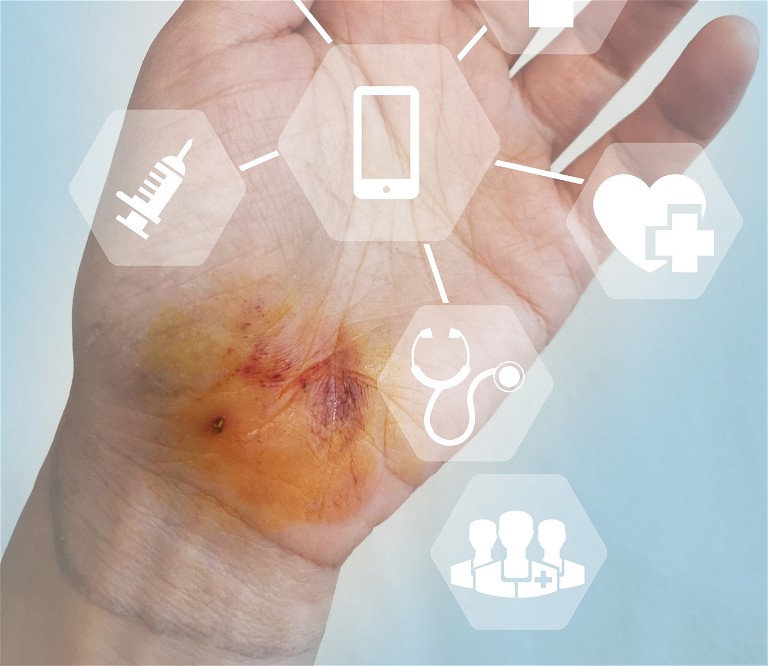Digital: AI and Wound Care
How can AI contribute to improving wound care in the UK
In the UK, one in 50 adults is living with a chronic wound, leading to more than £8bn in healthcare costs in 2017/2018.1 However, these numbers are likely to be higher since the pandemic as a result of reduced care in 2020 and 2021, impacting patient outcomes. With a growing ageing population and the increasing prevalence of people with comorbidities, these costs are likely to continue to rise until new solutions can be implemented to improve current standard care and control rising treatment costs
Bernard Ross at Sky Medical Technology
The treatment of chronic wounds, like leg ulcers, is labour-intensive and complex. Leg ulcers result from impaired blood flow in damaged or diseased leg veins, leading to complex physiological changes that result in skin breakdown and poor healing. Venous leg ulcers (VLUs), the most prevalent type of leg ulcer, are often long-lasting and can take months to heal. During this time, patients can experience severe pain and social isolation, among other physical and mental burdens, which can have a significant impact on their quality of life.
Ongoing treatment of wounds
Due to the unpredictable nature of healing, wound care is estimated to consume up to 65% of community nurses’ time in the UK.2 Healing can be a slow process and wounds that have not been appropriately managed are at a greater risk of becoming chronic. In fact, only 53% of VLUs heal within one year.3 Recurrence rates are also high – estimated at 57% by one year, leaving many patients suffering on an ongoing basis.4 Early identification and treatment are essential in preventing wounds from becoming chronic or hard to heal.
The recommended standard of care for VLU healing is compression therapy, which comes in the form of wraps, hosiery, two or four-layer bandaging, with a wide range of dressings and topical treatments. However, compression therapy, for some, can initially be extremely painful. To compensate for pain and other contributing factors, patients are at risk of receiving inadequate levels of compression. As a result, the current adherence to standard of care is reported to be between 12% and 52%.5 Under-utilisation of compression for VLU management also translates into lost opportunities to heal wounds, damages patients’ quality of life and reduces efficiency for healthcare systems.
Managing treatment complexities
VLUs need to be treated with consideration for the extent of venous disease present in the patient. This requires a good understanding and a diagnosis of the various components involved, and the possible additional health issues by the first-line clinician who encounters the patient. A multidisciplinary team is then necessary for a successful overall treatment plan and should then be tailored to each patient's specific needs and lifestyle.
Based on the above, and to ensure effective and consistent treatment is delivered across every level of care, healthcare systems and medical professionals require access to detailed patient data that can reveal more about the nature of chronic wounds. Opinion leaders and providers are unified in wanting this data-led approach to tackling wound care – not only to improve patient outcomes but to enable clinical research to be better conducted for valuable insights into care.
Building a national wound registry
Improved data collection can improve the consistency of care provided and deliver more personalised treatment plans for patients. Such data can drive clinical research in wound care and help the system adopt more innovative medical technologies to enhance treatments and reduce costs. The benefits of having access to such data have been shown in Wales, where a national wound registry has been built to better support healthcare professionals in delivering more efficient and timely care for wound patients and improve the quality of research in the sector.6 In these instances, patients and clinical teams can work together to determine appropriate treatments and share healing progress and other health information such as Patient Reported Outcomes Measures (PROMs). As suggested by Mölnlycke, a wound registry should include quality-of-life questionnaires to better support patients through the emotional and physical burden of living with chronic wounds.7 Therefore, a common approach to wound management allows clinicians to ensure patient health is continually improving.

Enhanced patient outcomes with AI
Artificial intelligence (AI) is becoming an increasingly valuable tool in healthcare to automate data-heavy tasks. Typically, patient data is reviewed and analysed by medical professionals and clinical teams to identify any patterns or anomalies – but this is a very time-consuming and labour-intensive process. With AI in place, a range of healthcare tasks can be made more efficient, such as data entry, analysing electronic health records and supporting clinical decision-making. With less time spent on competing labour-intensive tasks, more time can be spent by healthcare professionals to provide better care for their patients.
Other information, such as a patient’s medical history, can be used by AI to gather key insights. With correct use, AI could eliminate a lot of the pain points currently facing wound care, whether that is the analysis of a patient’s medical history, collection of data outlining a patient’s journey towards healing or automated alerts for any causes of concern.
Driving MedTech adoption
Improved data collection enables a greater understanding of a patient's medical history, such as previous health issues and common symptoms. By analysing this information with AI, healthcare professionals are able to identify what intervention is − and isn’t − as effective in delivering positive patient outcomes. In turn, this enables greater insight into which patients need additional treatment, which can lead to more tailored and effective healthcare strategies. Ultimately, this can help pave the way for faster development and adoption of new medical technologies that can address any gaps in treatments or unmet needs.
“ If these technologies can be used in the home setting by patients and their caregivers, this would offer the additional benefit of reducing community nursing time and help save treatment resources ”
AI can analyse health data and identify any areas where treatments may not be effective for patients with greater accuracy. Such solutions can be subsequently implemented into care pathways and used in conjunction with existing treatments to accelerate the healing of wounds. If these technologies can be used in the home setting by patients and their caregivers, this would offer the additional benefit of reducing community nursing time and help save treatment resources in the long run. Faster healing means improving patient outcomes and overall quality of life sooner and will help healthcare professionals deliver care to more patients over a given period. This has a plethora of benefits beyond the patient, freeing up nursing time and saving costs for the wider healthcare system.
Understanding the risks
Despite the promising potential of AI in healthcare, all AI-based processes should have a rigorous review to protect patient data and personal information. Sensitive information should remain protected from privacy violations and cyber security risks so strict regulations should be implemented from the offset. It is also crucial to ensure the human benefits of care are not lost through AI adoption.
Many elements of healthcare cannot be replicated by AI automation, for instance, checking and protecting patient mental well-being. Ultimately, healthcare professionals should have the final say on the best course of action for patient well-being. If used as a supportive resource to provide valuable insights into decision-making, the implementation of AI can become a useful tool for healthcare professionals.
Advancing wound care for a better future
Complexities such as labour-intensive treatment, low patient adherence and lack of clinical data all highlight why there is a need for innovation and a streamlined approach to wound care. The goal should be to deliver care that can heal chronic wounds, whether that is through accelerated healing or reduced recurrence rates, rather than managing wounds on an ongoing basis. Improved data collection is critical in achieving this goal − helping clinicians better understand the factors that impact non-adherence and any alternative treatments that may be more effective depending on patient needs. Ultimately, AI can speed up this process and help bring enhanced care to patients.
While the use of AI in wound care is at an early stage, the technology is being used to automate tasks and improve decision-making. By embracing AI to automate data collection and analysis, healthcare systems can gather valuable insights to drive improved patient outcomes. Access to this data, if managed responsibly, will help clinicians conduct life-changing clinical research. With considerate and well-thought-out input from healthcare professionals, AI can be used as a valuable tool to improve the quality of care for patients to pave the way for a brighter future in healthcare.
References
- Visit: bmjopen.bmj.com/content/10/12/e045253
- Visit: woundsinternational.com/consensus-documents/simplifying-venous-leg-ulcer-management-consensusrecommendations/
- Visit: onlinelibrary.wiley.com/doi/10.1111/iwj.12814
- Visit: ncbi.nlm.nih.gov/pmc/articles/PMC7757484/
- BarLetal (2021), 'Improving Adherence to Wearing Compression Stockings for Chronic Venous Insufficiency and Venous Leg Ulcers: A Scoping Review. Patient preference and adherence,' 15, 2085–2102. https://doi.org/10.2147/PPA. S323766
- Visit: wwic.wales/uploads/files/documents/Publications/Annual%20Report%202016.pdf
- Visit: molnlycke.co.uk/contentassets/edf1a334aadd4bcea31bf27621f45d77/making-woundcare-work---may-2022.pdf

Bernard Ross, CEO and founder of Sky Medical Technology is a serial entrepreneur with more than 20 years’ senior experience at private and public board level across multiple industries including pharmaceutical, technology development and FMCG. Bernard is a former head of International Development at CMI, senior vice president, Cardiovascular of Bioaccelerate and former CEO of Innacardio.